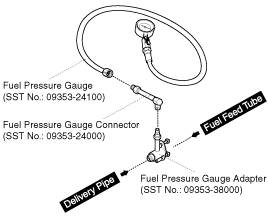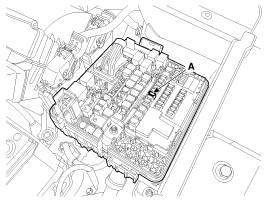 Kia Sedona: Repair procedures
Kia Sedona: Repair procedures
Third generation YP (2014-2025) / Kia Sedona YP Service Manual / Engine Control / Fuel System / Fuel Delivery System / Repair procedures
| Fuel Pressure Test (Low pressure system) |
| 1. |
Release the residual pressure in fuel line.
(Refer to the Fuel Delivery System - Repair Procedures - "Release Residual Pressure in Fuel Line").
|
| 2. |
Install the Special Service Tool (SST).
|
| 3. |
Inspect fuel leakage on connections among the low fuel feed
tube, the low pressure inlet of high pressure fuel pump, and the SST
components with IG ON. |
| 4. |
Measure Fuel Pressure.
|
| 5. |
Release the residual pressure in fuel line.
(Refer to the Fuel Delivery System - Repair Procedures - "Release Residual Pressure in Fuel Line").
|
| 6. |
Test End
|
| Release Residual Pressure in Fuel Line |
Whenever the high pressure fuel fuse, fuel pipe, delivery
pipe, or injector is removed immediately after shutting off the engine,
an injury may be caused by the release of highly pressurized fuel.
Release the residual pressure in the high pressure fuel line by
referring to the "Residual fuel pressure release procedure" below before
removing any high pressure fuel system components.
|
Wear safety glasses and fuel resistant gloves.
|
| 1. |
Turn the ignition off and disconnect the battery negative (-) terminal. |
| 2. |
Remove the fuel pump fuse (A).
|
| 3. |
Reconnect the battery negative (-) terminal. |
| 4. |
Run the engine for about 1 minutes to lower the pressure in the low pressure line. |
| 5. |
Turn the engine off. |
| 6. |
Disconnect the low pressure fuel line quick connector at the
High Pressure Pump. Use rags to cover opening and catch spills while
removing the fuel line. |
| 7. |
Start the engine, let it idle and then turn the ignition switch OFF after the engine has stopped on its own. |
| 8. |
Proceed with the service or repair. Use rags to cover opening and catch spills when opening up the high pressure system. |
| 9. |
Reinstall / re-connect all components in reverse order of
removal. Start engine and confirm proper operation, and make sure there
are no fuel leaks. |
| 10. |
After completing, clear DTC(s) using GDS scan tool. (The procedure descripbed above will cause DTC to set.) |
 Components and Components Location
Components and Components Location
Components Location
[Fuel Tank]
1. Fuel Tank2. Fuel Pump3. Fuel Filter4. Fuel Pressure Regulator5. Canister6. Fuel Tank Air Filter7. Fuel Tank Pressure Sensor (FTPS)8. Canister Close Val ...
 Fuel Tank Repair procedures
Fuel Tank Repair procedures
Removal
1.
Release the residual pressure in fuel line.
(Refer to the Fuel Delivery System - Repair Procedures - "Release Residual Pressure in Fuel Line")
2.
Turn the ignition switch OFF and ...
Other Information:
Tilt and telescopic steering
Tilt and telescopic steering allows you to adjust the steering wheel before you
drive.You can also raise it to give your legs more room when you exit and enter
the vehicle.
The steering wheel sho ...
Placing a passenger seat belt into the auto lock mode
The auto lock mode will help prevent the normal movement of the child in the
vehicle from causing the seat belt to loosen and compromise the child restraint
system. To secure a child restraint s ...
Categories
- Home
- First Generation
- Second Generation
- Third generation
- Kia Sedona YP 2014-2025 Owners Manual
- Kia Sedona YP 2014-2025 Service Manual
Copyright ┬® www.kisedona.com 2016-2025




